I'm unsure. Haven't had many paints to confirm what's going on with that particular bird.Does OP's male look dun to you? Or is he probably paint (heterozygous Dominant White) with large amounts of leakage?
Navigation
Install the app
How to install the app on iOS
Follow along with the video below to see how to install our site as a web app on your home screen.
Note: This feature may not be available in some browsers.
More options
You are using an out of date browser. It may not display this or other websites correctly.
You should upgrade or use an alternative browser.
You should upgrade or use an alternative browser.
BBS breeding and dilute / white splash
- Thread starter 2ndTink
- Start date
I appreciated that you typed the whole long thing, instead of me doing it
And I'm happy to see more and more people with enough knowledge to answer these kind of questions, rather than just a few (who might be busy on a given day, or just not feel like answering at a particular time. I've noticed that with myself, and I think I also see it with some of the other people who are good at genetics.)
I definitely get that, yes. Much as I love helping people with genetics, as an introvert with severe social anxiety, social interactions actually get to be exhausting to me at times. So, needless to say, I definitely understand just not feeling like responding to things! And I struggle with other aspects of social anxiety that make it hard for me to post even if I am confident I know the answer, so sometimes I just can't get myself to respond even if I want to because my anxiety gets too bad. I definitely appreciate those with similar or more experience not only stepping in to answer on those days, but also pointing out where I made mistakes as well. Not only would I much rather not spread misinformation or partial information, but accepting that you have made a mistake is learning from that mistake, and I love to learn!
You have more experience than me in identify walnut-mix combs.
Assuming you are correct about what comb genes he has, I agree with your predictions and I think you did do the math correctly.
You are not allowing for combs looking different if they have two copies of the pea comb gene (homozygous) vs. one copy (heterozygous). Two copies will be present in some of the "pea comb" and "walnut comb" chicks from mothers with pea combs. One copy will be present in some chicks from those mothers, and in all "pea comb" and "walnut comb" chicks from mothers with single combs.
Two vs. one copy of the pea comb gene can make a big difference in the appearance, or can be almost identical in appearance. I've seen examples either way, so I assume there must be some other genes that change exactly how the comb appears in heterozygotes (one copy of the pea comb gene).
Case in point, haha! Yes, I somehow as aware enough to mention the difference in inheritance for heterozygous and homozygous pea comb, but forgot to mention expression differences in the offspring. Got too caught up in the math, I guess!
My Dun Malay has black in his hackles, & saddles. Will get close ups in a bit. The pictures I have currently aren't good enough to show that.
I also did read somewhere here, that Dun does leak black sometimes.
Is he unicolor dun or patterned dun? That makes a big difference.
Yes, black flecks come through in dun as well, I just would not expect that much frequency in flecking based on my experience with the gene. I guess I could have been clearer in that statement.
Dun based on extended black or melanized birchen, as the OP's bird would have to be in order to be unicolor dun, would also be a much darker shade of dun, almost chocolate-colored. He's too pale for unicolor dun, in other words. Khaki, I^d/I^d, does not let black flecks through at all, so that would not explain the color of OP's bird, either.
Last edited:
Well here's my Dun Malay with black in hackles, & saddles. Attempted to get just his brown/Chocolate color, but the lighting due to the snow wasn't great.Does OP's male look dun to you? Or is he probably paint (heterozygous Dominant White) with large amounts of leakage?
Well here's my Dun Malay with black in hackles, & saddles. Attempted to get just his brown/Chocolate color, but the lighting due to the snow wasn't great.
View attachment 3725793View attachment 3725794View attachment 3725795
Yeah, unfortunately the lighting makes it hard for me to really make out what you're trying to show with these pictures.
Closest to his color I can find, just lacks the black/splashes.
View attachment 3725801
That looks like heavy gold or golden leakage coming through heterozygous dominant white to me. Zooming in, you can see black flecks and shafting in the tail typical of heterozygous dominant white. I honestly can't think of a way where Splash x Porcelain could produce such a bird...
- Thread starter
- #45
- Aug 23, 2020
- 4,001
- 18,619
- 766
Well, color me confused! I somehow missed a notification on this thread, just came back to it to re-read what yall had written and found a complete added treasetrive of genetics info!
I'm only partway through @NatJ s #36 post and I'm really wondering what color Chonkers is now. I'm going to go read all the posts from the last week, I'm super excited, thank you all so much!
I'm only partway through @NatJ s #36 post and I'm really wondering what color Chonkers is now. I'm going to go read all the posts from the last week, I'm super excited, thank you all so much!
- Thread starter
- #46
- Aug 23, 2020
- 4,001
- 18,619
- 766
Ok, first read through completed and 
Here's what I know of Chonkers genetics, the rooster was a chocolate frizzle silkie, he must be true sexlinked chocolate because none of the hens he was in with were chocolate, yet I purchased 3 chocolate pullets from the breeder from the same pen I got the hatching eggs from. There was a satin paint in the pen with the chocolate rooster who must be the hen Chonkers came from. I have no idea beyond that what they may have had going on genetically.
Here are two more views of Chonkers
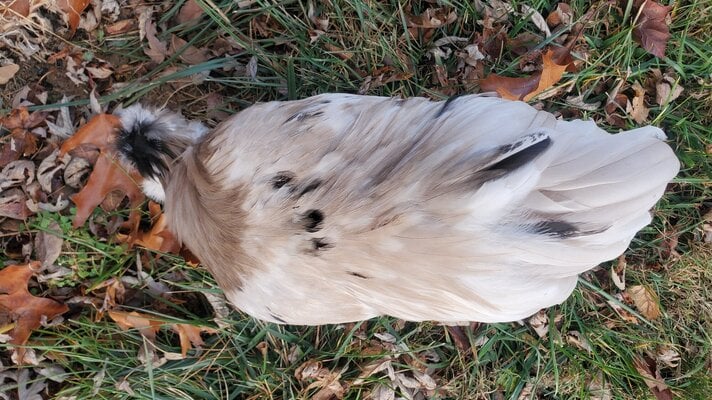
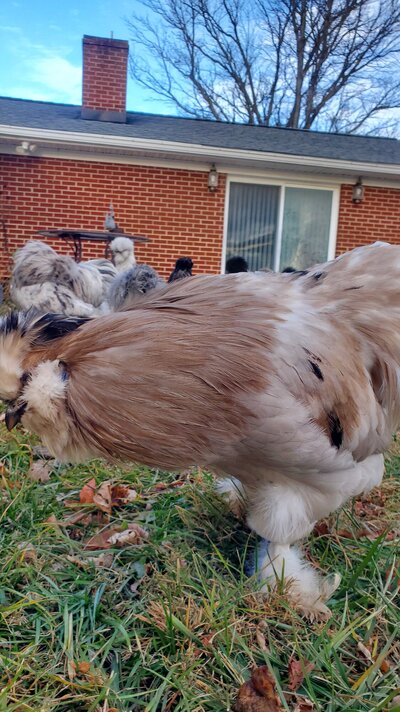
And here is another cockerel from the same pen, black frizzle with a funky comb @pipdzipdnreadytogo I would love to hear your thoughts on his comb genetics.
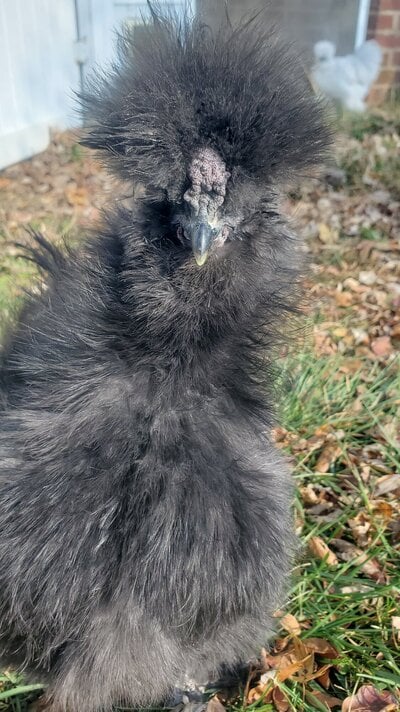
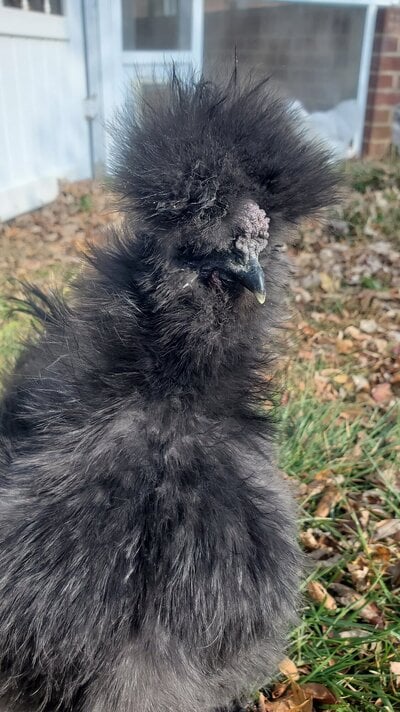
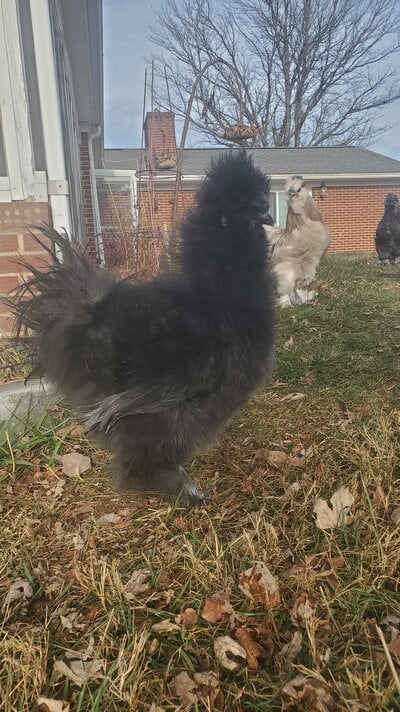
I have to make dinner, but I'm going to re-read everything again tonight, this is fascinating stuff!
And I totally understand anxiety and being an introvert. They are a constant challenge for me and yes, some days I just can't... so thank you so much for helping me out ❤
so thank you so much for helping me out ❤
Here's what I know of Chonkers genetics, the rooster was a chocolate frizzle silkie, he must be true sexlinked chocolate because none of the hens he was in with were chocolate, yet I purchased 3 chocolate pullets from the breeder from the same pen I got the hatching eggs from. There was a satin paint in the pen with the chocolate rooster who must be the hen Chonkers came from. I have no idea beyond that what they may have had going on genetically.
Here are two more views of Chonkers


And here is another cockerel from the same pen, black frizzle with a funky comb @pipdzipdnreadytogo I would love to hear your thoughts on his comb genetics.



I have to make dinner, but I'm going to re-read everything again tonight, this is fascinating stuff!
And I totally understand anxiety and being an introvert. They are a constant challenge for me and yes, some days I just can't...
 so thank you so much for helping me out ❤
so thank you so much for helping me out ❤Definitely better lighting. I can now see he's not yellowish. More like a "dirty" Splash. Best I can describe.Ok, first read through completed and
Here's what I know of Chonkers genetics, the rooster was a chocolate frizzle silkie, he must be true sexlinked chocolate because none of the hens he was in with were chocolate, yet I purchased 3 chocolate pullets from the breeder from the same pen I got the hatching eggs from. There was a satin paint in the pen with the chocolate rooster who must be the hen Chonkers came from. I have no idea beyond that what they may have had going on genetically.
Here are two more views of Chonkers
View attachment 3730619
View attachment 3730620
And here is another cockerel from the same pen, black frizzle with a funky comb @pipdzipdnreadytogo I would love to hear your thoughts on his comb genetics.
View attachment 3730625View attachment 3730626
View attachment 3730622
I have to make dinner, but I'm going to re-read everything again tonight, this is fascinating stuff!
And I totally understand anxiety and being an introvert. They are a constant challenge for me and yes, some days I just can't...so thank you so much for helping me out ❤
Once most of the snow melts, my cracked phone camera should pick up the color better, but I can also do a side by side with a black, which may help.Yeah, unfortunately the lighting makes it hard for me to really make out what you're trying to show with these pictures.
Found this as a possibility of the coloration. But the rooster may also be a "dirty" Splash, but really hard knowing without test breeding.
 https://www.pet-hens.co.uk/silkies/
https://www.pet-hens.co.uk/silkies/
- Thread starter
- #50
- Aug 23, 2020
- 4,001
- 18,619
- 766
Ok, what should I test breed him to? What would we be looking for?Found this as a possibility of the coloration. But the rooster may also be a "dirty" Splash, but really hard knowing without test breeding.
View attachment 3730654https://www.pet-hens.co.uk/silkies/
I have:
Black Australorp
Rhodes Island Red
Barred Rock
SLW
EE (so probably not these..)
For silkies:
Black
Splash
It will be this fall but I'll have more silkies:
Paint
Chocolate
Blue
New posts New threads Active threads
-
Latest threads
-
Day 30 on Sebastopol goose eggs- No external pip!
- Started by Mrs Fryzzle
- Replies: 0
-
What are your stories of 'late' eggs hatching?
- Started by Henora
- Replies: 0
-
Chicken been eating more and been hot lately, should I be worried?
- Started by Chixlittlelogan
- Replies: 0
-
Sick pullets - vet nurse says it looks like enteritis - help working out a tri-Sulfa dose?
- Started by JoanieShrubs
- Replies: 2
-
Sumatra Chicken Sex-Link
- Started by Down Under
- Replies: 0
-
-
Threads with more replies in the last 15 days
-
-
-
Open Contest BYC's 4th of July Star Spangled Hatch-Along—Stars, Stripes, & Feathers, a Text-to-Image Contest
- Started by Debbie292d
- Replies: 118
-
-
Does everyone stress ordering chicks the first time 😱
- Started by Esrun
- Replies: 79
-



